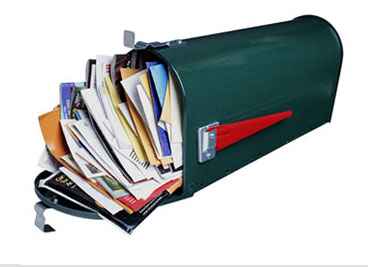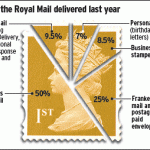Before I begin this blog, worth saying that I’m not unbiased on this topic. Far from it – I don’t like advertising or marketing being pushed in my face via any medium, and sales people should be like children, seen and not heard, speaking only when spoken to. There are many aspects of the sales and marketing industry that incur my wrath, though arguably the avalanche of waste paper shoved through our doors unsolicited must be among the most irritating – along with the email equivalent (spam) and the shoals of inserts falling out when you open a magazine.
Neither am I a fan of the Daily Mail (confusing – too many Mails!), but on this occasion the paper has got it spot on in its analysis of the topic, worth repeating in full (though see also this article from the Guardian for greater context):
An avalanche of junk mail: Nearly half daily postbag is now direct marketing… and the Royal Mail wants us to get even more!
- The revelation means up to 27million of the 54million items of daily post are junk mail
- The rise is fuelled by the removal a year ago of a cap that stopped postmen delivering more than three unaddressed letters to a house in a week
- This – along with much higher stamp prices – saw Royal Mail report vastly improved operating profits yesterday
- ‘Most people don’t appreciate being bombarded with junk mail on a daily basis’ said the Local Government Association
Almost half of all postal deliveries are junk mail, it was revealed yesterday.
And Royal Mail admitted the volume of unwanted letters will only grow in its drive to make bigger profits. The revelation means up to 27million of the 54million items of daily post are junk mail.
The rise is fuelled by the removal a year ago of a cap that stopped postmen delivering more than three unaddressed letters to a house in a week. This – along with much higher stamp prices – saw Royal Mail report vastly improved operating profits yesterday.
Clyde Loakes, of the Local Government Association, said junk mail was a menace: ‘The LGA has previously raised concerns about the impact of Royal Mail scrapping its limit on unsolicited mail,’ he said. ‘The revelation that half of the postbag is now direct marketing material proves those concerns were not ill founded. Most people don’t appreciate being bombarded with junk mail on a daily basis. Not only is it a nuisance to have to pick up and throw away, but it adds thousands of tons to the amount of waste councils have to collect.’
Robert Hammond, of the campaign group Consumer Focus, said: ‘Some consumers may find it frustrating that almost half of mail received now is direct marketing and that this will be contributing to higher profits. However the hard fact is that without this revenue stream for Royal Mail and the associated profits, customers could in fact face paying more for their stamps.’
Royal Mail made £144million in the first half of the year compared with only £12million in the same period of 2011. Around £1billion of its annual revenues come from junk mail.
Moya Greene, Royal Mail’s £1.1million-a-year chief executive, said such ‘direct marketing’ was approaching 50 per cent of all deliveries. She described herself as a huge fan of the ‘powerful medium’, adding: ‘We are poised to increase our share of it.’
In July, Royal Mail launched Market Reach, which is a one-stop shop for firms that want to use junk mail. Miss Greene said the service would design postal messages, identify potential addresses, carry out deliveries and deal with responses from customers.
Between March 26 and September 23, Royal Mail delivered a record-breaking 1.6billion items of unsolicited mail to Britain’s 29million addresses. It also delivered 6.8billion addressed letters – some of which would be junk mail.
The growing profitability of Royal Mail opens up the possibility of it being floated on the stock market or sold off to a rival. Michael Fallon, Tory business minister, said yesterday: ‘Parliament decided, via the Postal Services Act 2011, to inject private capital into the company in order to secure the future of the universal postal service.
‘The structure and timing remain open, but Government is committed to doing that to ensure the ongoing viability of the company.’ A potential sell-off has been helped by shifting responsibility for Royal Mail’s pension fund to the taxpayer. Assets of £28.5billion were transferred to the Government along with £37.6billion of liabilities, which are the cost of pension promises to postal workers and its retired staff.
Yesterday’s financial results revealed how the stamp price hike has hit Royal Mail’s letters business, with the number of letter deliveries dropping by 9 per cent. Miss Greene said however that 50p for a second-class stamp was a bargain. Insisting she did not mean to be ‘glib or flip’, she added: ‘Realistically, what can you buy for 50p today?’
Ah, but the Mail also helpfully prints details of how to minimise your junk mail via the Mail Preference Service:
HOW TO REDUCE YOUR JUNK MAIL
Junk mail can be reduced by registering with The Mailing Preference Service. It is free and allows householders to remove their names and addresses from many marketing lists. You can register on the website www.mpsonline.org.uk or by calling 0845 703 4599.
This article is more interesting though, giving more effective ideas for bypassing the system, but even the MPS doesn’t stop Royal Mail delivering their messages from advertisers, so it seems we have little or no defence to this tide of unwanted paper – and it’s going to get worse, according to the Daily Mail.
The industry would argue that it’s a “recession buster”. This mail, they claim, generates revenue where none would otherwise be created. Among the gullible, maybe, in which case the consumer should rightly be protected against abuses.
Several points are worth making about junk mail to put it in context. The first is that “unaddressed mail” like this achieves a typical response rate of 0.05%, mostly because it’s utterly irrelevant to the recipients. Even “targeted mail” addressed to a specific householder is lucky to get 5% responses, and most considerably less. More than that, you often wonder how your details have been obtained (mostly purchased databases, often containing illegally held information), or how they claim to believe you have the remotest interest in their products – 99.999% of the time that is not true, and even if it were would I buy those products from that company?
Let’s suppose you do need a product or service though, and, hey presto, a flyer comes through your door advertising that service locally. Unless it was just a pizza parlour, surely you would you never just buy from that one because they sent a leaflet? Being a sensible shopper, you would shop around, do your own research and draw up a list of suppliers that met your criteria – in other words, make a wise investment based on a sensible process. What advertisers want you to do is be emotionally attracted to the supplier and to make a decision with heart, not head – but are bits of paper through the door really the way to achieve that?
Yet the industry still claims its research says the majority of households value and appreciate such information, coupons, catalogues, promotions, whatever it happens to be. I fervently dispute that claim. The vast majority of these mail-outs go directly into the bin, and I have no recollection of ever buying any goods as a direct result of direct marketing – unless it was a shop I already frequented (eg. takeaway menus.)
This in my eyes makes direct vastly wasteful and unnecessary as well as ineffective in the extreme – just think of all the waste paper generated by this trade! From the eyes of the advertisers, one response may fund the campaign, depending on the product, which does not excuse the waste of time and money which would be better spent on actually making quality products and selling them to people who are actively looking for that product.
Actually, it’s worse than that since a great deal of this mailing is counterproductive. It enrages many people to the extent that they would actively seek to buy products from anyone but the people who send this awful material through their doors. Who can blame them? It is an invasion of privacy, and our protestations to stop flyers, circulations and other forms of junk mail are routinely ignored.
So how to stop it or what to do with it? Some friends have ideas:
I bundle it up and put it all in a random prepaid envelope and stick it back in the post
One solution – give them a taste of their own medicine, but to do that you need to spend your own valuable time and effort, which surely defeats the purpose? A postman writes:
Put a little sign on your letter box asking for no leaflets to be delivered. I never deliver to anyone who does that. May not stop the non RM leaflet distributors though unfortunately
Nor indeed do other posties take any notice of such signs anyway.
You can get in touch with your local delivery office and request no junk mail this stops leaflets etc, but they still have to deliver anything that has your actual address on. but it cuts down on the crap considerably
Hmmmmm worth a try with the Tiptree sorting office. More than that:
If you dont want unaddressed items you can actually request for that info to be placed un our delivery logs.
Of course, I’d argue none of this should be necessary. We shouldn’t have to be bombarded with junk mail, nor should we ever be a position where our principle carrier depends on the revenue gained from advertising to survive. It would be good for companies to apply intelligence rather than sheer volume to let us know of their existence, find ways to be responsive rather than in our faces, and most of all to respect our desire to escape from the incessant drivel they thrust at us daily.







